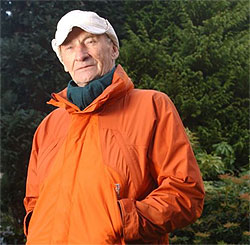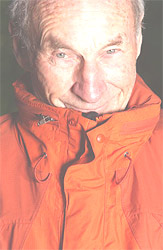Snowmen Seeker? Pamir Expedition Leader Dies
Posted by: Loren Coleman on June 30th, 2007
Little is known of what the Soviet Russians did on their Pamir Mountains’ “Snowmen” expeditions of the 1960s, especially if they contained non-Russian members.
What were their goals? What did they find? Was Tom Slick or one of his friends secretly involved in funding one such expedition?

Malcolm Slesser.
The death on Tuesday, June 26, 2007, announced today, of Malcolm Slesser, 82, is bringing to mind such questions anew.
Slesser died doing what he loved best, climbing a mountain.
According to the Scotsman on Saturday, June 30, 2007, the “veteran mountaineering expert from Edinburgh fell to his death from a clifftop while climbing in the Highlands. [He] is thought to have suffered a heart attack and fallen on to his 78-year-old wife, who suffered minor injuries….The couple, of Findhorn Place, Newington, [Scotland] were climbing at Loch Ailort on the Ardnish Peninsula.”
The article further noted: “Prof Slesser was one of Scotland’s most distinguished mountain explorers, climbing peaks in Scotland, Greenland, Brazil and Peru. His favourite mountain area in Scotland was Wester Ross, which he said was ‘similar to Greenland, although not quite so dramatic.'”
He had a remarkable mountaineering career and his death is the end of an era. Although he was 82, he was extremely spry and was active right to the end. – John Fowler, the Scottish Mountaineering Club.
Slesser’s most famous mountaineering book is Red Peak: A Personal Account of the British-Soviet Pamir Expedition 1962 (London: Hodder & Stoughton; 1964). I have never read this book, but I want to now or have someone who has it tell me what details it contains that impact on cryptozoology. Slesser was the deputy leader of the expedition; Sir John Hunt was the leader. Hunt, of course, is well-known for his presence on expeditions that overlapped with the search for or new discoveries of relics of the Yeti.

John A. Jackson and Sir John Hunt, both of whom were members of the 1954 Daily Mail Abominable Snowman Expedition.
More often than not, however, past discussions of Red Peak have been overshadowed by its contents on the mysterious and tragic deaths of two British climbers, Wilfrid Noyce and Robin Smith.
As Slesser once noted in a 2004 interview: “Noyce and Robin, along with two Russians, Ovchinnikov and Sevastianov, had successfully climbed Garmo and were heading down an easy, but steepening, snow slope. For reasons we will never know, Smith unroped from Ovchinnikov and roped up with Noyce. It was a very strange thing and we will never discover the truth. It was a very silly accident but in many ways both were an accident waiting to happen. Both of them were confident and very carefree climbers.”
As that 2004 article in the Scotsman also revealed, the 1962 Pamirs expedition was “partly funded, bizarrely, by a Texan oilman to encourage détente between East and West.”
Could this have been Tom Slick, who had visited Russia and was interested in World Peace? Was it also partially funded to seach for “Snowmen”?
Did this expedition involve Slesser in an effort to discover more about the “Snowmen” of the Pamirs.
In Myra Shackley’s 1982 book, Still Living? (1982), in her Chapter 7 “The Pamir Expeditions,” she writes: “For the hominid point of view the area clearly has great potential as a refuge, and evidence suggests that it conceals both the small Almas-like variety and the larger, Yeti-type, primate.”
While Shackley’s overview nicely covers the findings and expeditions from 1930s through 1958, the 1960s and most of the 1970s are a void in her “history.” How many American, British or Scottish climbers were on the Soviet “Snowmen” expeditions in the Pamirs in the 1960s? How many were there with a partial objective to search for unknown hairy hominids?
Slesser’s death has me asking many new questions about what occurred – other than just mysterious deaths – on the British-Soviet-Hunt-Slesser expediton of 1962.

About Loren Coleman
Loren Coleman is one of the world’s leading cryptozoologists, some say “the” leading living cryptozoologist. Certainly, he is acknowledged as the current living American researcher and writer who has most popularized cryptozoology in the late 20th and early 21st centuries.
Starting his fieldwork and investigations in 1960, after traveling and trekking extensively in pursuit of cryptozoological mysteries, Coleman began writing to share his experiences in 1969. An honorary member of Ivan T. Sanderson’s Society for the Investigation of the Unexplained in the 1970s, Coleman has been bestowed with similar honorary memberships of the North Idaho College Cryptozoology Club in 1983, and in subsequent years, that of the British Columbia Scientific Cryptozoology Club, CryptoSafari International, and other international organizations. He was also a Life Member and Benefactor of the International Society of Cryptozoology (now-defunct).
Loren Coleman’s daily blog, as a member of the Cryptomundo Team, served as an ongoing avenue of communication for the ever-growing body of cryptozoo news from 2005 through 2013. He returned as an infrequent contributor beginning Halloween week of 2015.
Coleman is the founder in 2003, and current director of the International Cryptozoology Museum in Portland, Maine.










He could have just stayed home and looked for the Big Grey Man of Ben MacDhui.
Have Just ordered book Red Peak, I will let you know